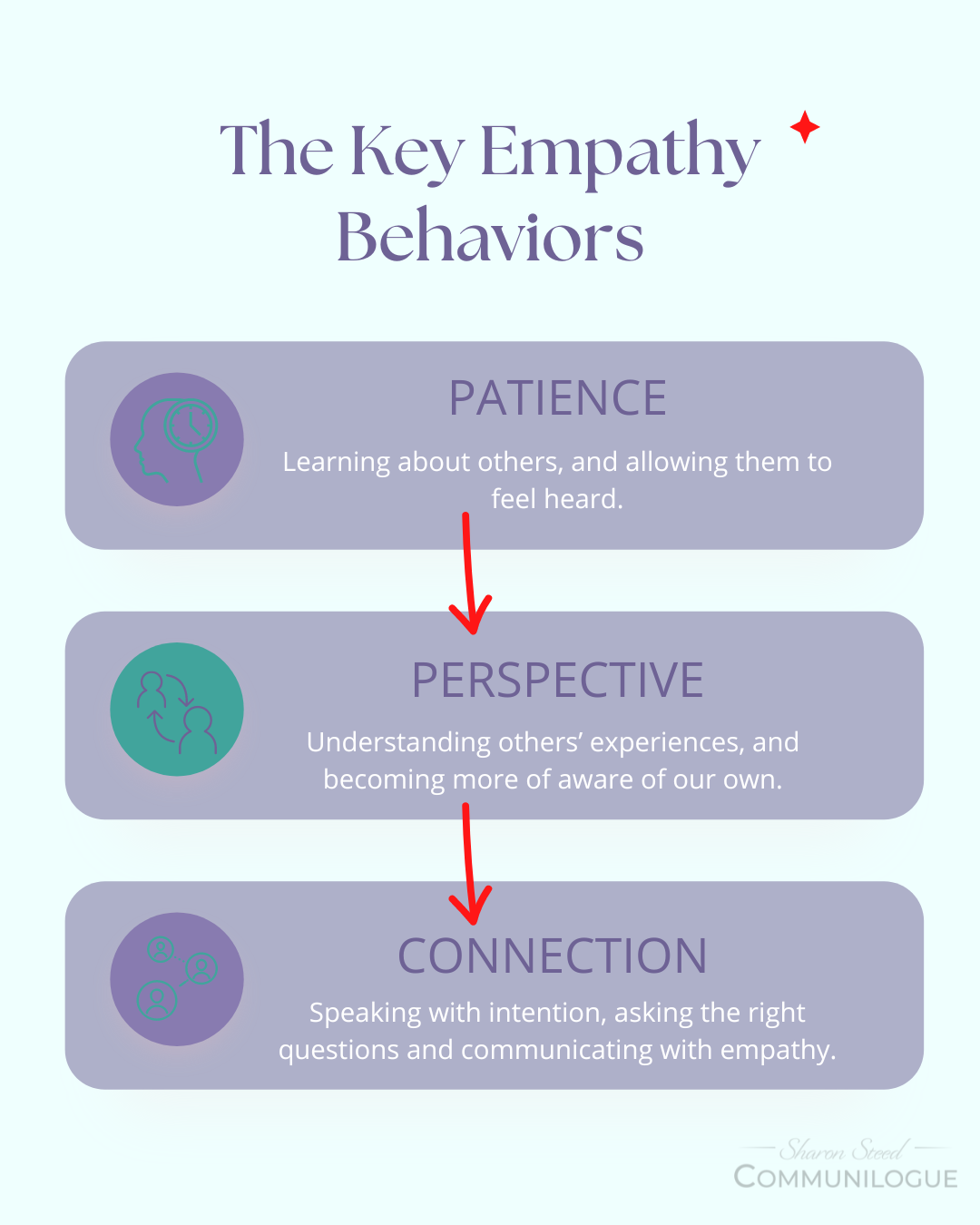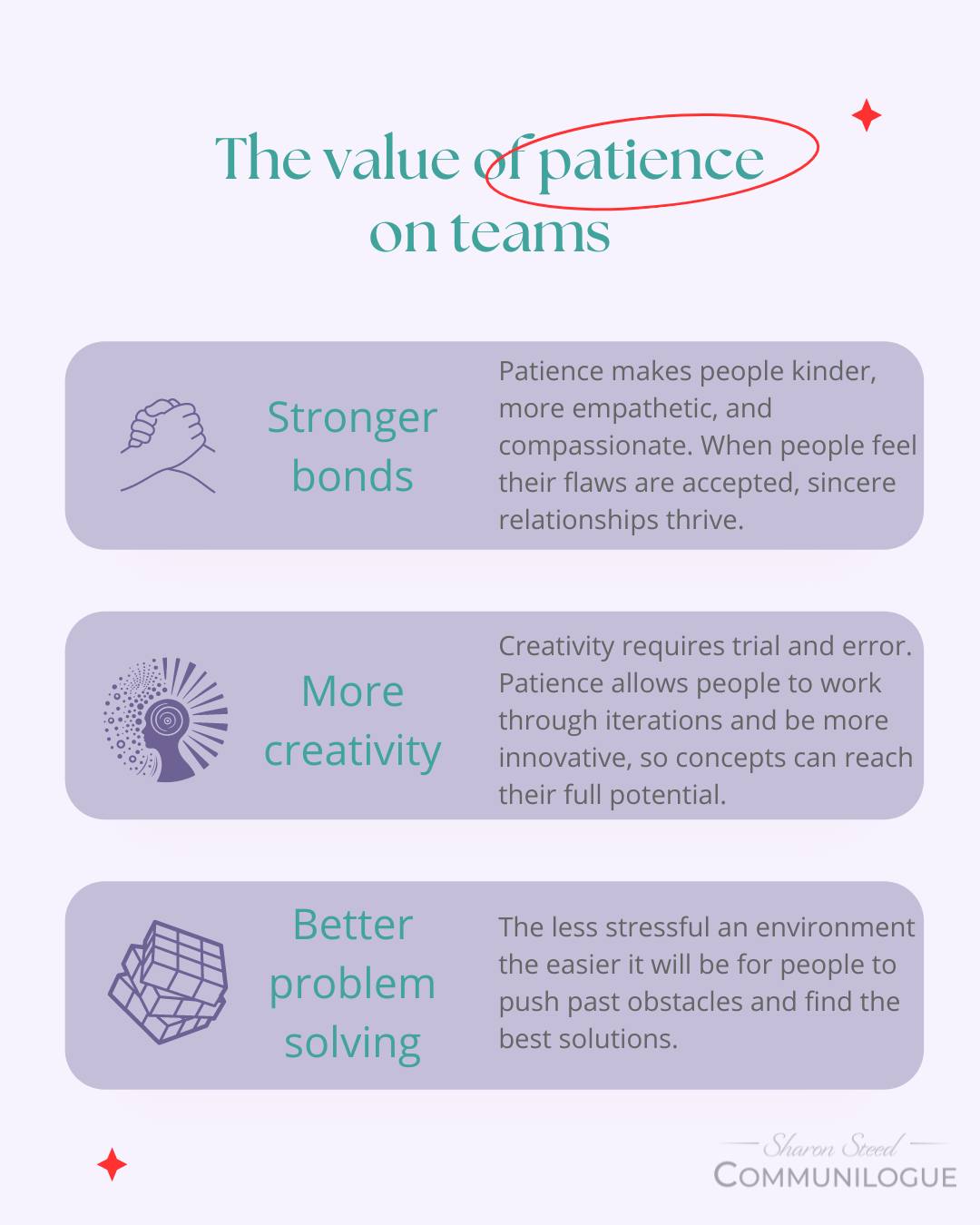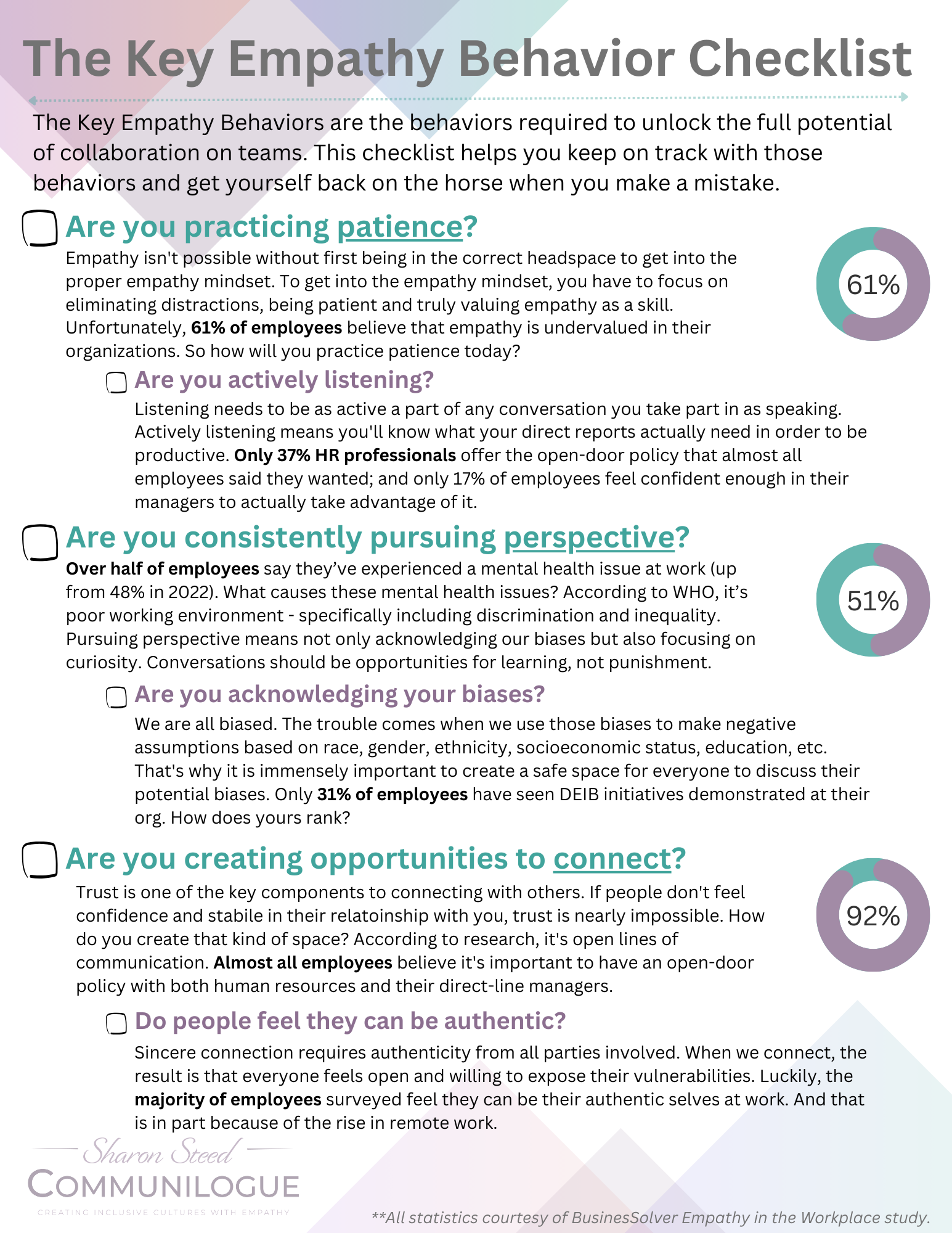The Key Empathy Behaviors
“Teamwork makes the dream work”
We’ve all heard this quote, and it’s as true now as it was back in 2002 when clergyman John C. Maxwell released his book of the same name. But we rarely hear the rest of this quote where Maxwell gives a bit more context on the how of this sentiment:
“Teamwork makes the dream work, but a vision becomes a nightmare when the leader has a big dream and a bad team.”
Teams only work well together if everyone is on board. There needs to be mutual respect; open lines of communication; transparency and clarity on roles and responsibilities; and a culture of both ownership and accountability. Success on teams is never by accident; it is intentional and earned.
That success usually comes at the cost of your comfort zone. Everyone needs to be willing to hear ideas that are out of the norm; consider perspectives that are in their blind spot; and be brutally honest about wins and losses. In short, every team member needs to be confident being a bit vulnerable.
Vulnerability is a scary proposition, but it’s a necessary tool in building productive and successful teams. Why? Because it promotes trust. We assume that we need trust to be established before vulnerability comes into play when what we actually need is to start with vulnerability in order to create trust. And all of this can be done with empathy at the core of our interactions. Enter: Key Empathy Behaviors.
The Key Empathy Behaviors help you unlock the power of collaboration on your teams. They help build trust, and trust improves performance. They improve communication; people need to feel heard to be successful. And they make empathy actionable so it’s easier for everyone on the team to be successfully collaborative.
PATIENCE
Patience is a great aid in learning not just new skills, but about others. The more patient you are, the more you encourage collaboration. With patience, the focus is on listening. And we should be listening to understand rather than just to respond. As we listen with more intention, we are creating a more collaborative environment because people feel heard. That makes working together a more enjoyable experience for all involved. When people are having fun, they are more equipped to solve problems efficiently. And leaders who demonstrated patience helmed teams who felt more creative and collaborative.
So improving patience is important to keeping teams happy and productive. Remember that patience is a behavior, and we need to view it as such when we are aiming for it in every situation. With that in mind, let’s determine the ques you need to focus on when operationalizing improving patience.
Know your triggers and know how to combat them
None of us are perfect. We all struggle with something – especially in professional settings. But the key is to not let those battles turn into long-term wars. And it’s easy to fall into that trap, allowing ourselves to fall into the “I’ll never get past this so I’ll just deal with it” trap. But when it comes to being more patient, the goal is to actually improve; the benefits are well documented for both personal and professional reasons.
Identify what triggers you to rush through situations; what activates your “I’m annoyed” response; and what moments you find your attention wandering elsewhere. Determine what happened right before those situations to cause your impatient reaction. Then, establish counter behaviors to get you back into the moment.
Remember the why
Conversations are rarely linear. They’re often journeys into whatever is on each participant’s mind at that very moment. This can often be a great thing because each interaction with someone is an evolution of our relationship with them. Allowing them to speak freely about what they’re thinking and feeling is integral is building a solid connection.
This can, however, make it more difficult to stay focused on the person, the conversation, and the task at hand. So, when you’re struggling to be patient in conversation with someone, remember the why: the ultimate goal of the interaction. Keeping the “why” at the forefront makes it easier for everyone to stay on track and to achieve the desired objective.
Feel your feelings
No one ever benefited from pushing away their emotions. In fact, this can increase stress which raises the risk of major health issues like heart disease, headaches and autoimmune disorders. Acknowledging your emotions – wherever they fall on the spectrum – frees you from the burden of carrying them around. The handcuffs of stifling how you feel makes listening harder and having sincere, productive interactions nearly impossible.
If you feel a surge of emotions coming on that could possibly impact your patience, speak openly about it using “I” statements and in a respectful way. Be sure not to blame the other person for how you are feeling and make that sentiment clear to them as well.
PERSPECTIVE
Perspective taking is when you are trying to understand where others are coming from: what they mean, how they feel, and why they take the view that they do. This Key Empathy Behavior puts the focus on getting context as the Dictionary.com definition of it denotes: “the faculty of seeing all the relevant data in a meaningful relationship.”
When we are pursuing perspective, people feel validated and respected because we are showing a genuine interested in seeing why they feel a certain way. They feel much less defensive when their feelings being acknowledged, and that leads to more constructive and open communication.
But the other side of perspective taking is just as important; it opens our eyes to who we are, what we feel and how we think. We all have a vision of ourselves, and it has tendency to be idealized. Because of that, it’s not always aligned with how others see and feel around us. When we are committed to consistently pursuing perspective, we are confronting our true selves. We’re not only questioning the validity of our beliefs, but also how those beliefs are impacting our ability to succeed in a team setting.
You don’t know everything
We forget that we only know a small piece of the people around us. They show us who they are both intentionally and unintentionally, but ultimately we are seeing a very limited portion of who this person is. We have no idea what’s going on in someone’s life that is causing them to behave in certain ways.
Remind yourself that you do not have context; you do not know the full situation. Therefor you should be slower to both judgement and defensiveness. Remember, things are rarely about you.
Think before you speak
Most of us approach conversations from a reactive space. We hear what someone says, and immediately just start talking to fill the silence or move the conversation in the direction we are aiming for. What we should actually do is take a beat and process what the person has said to us.
What words did they use? What is their body language broadcasting? Did they seem confident and certain or timid and insecure? Where is that underlying feeling coming from? Thinking before you speak means embracing the speaker’s entire message. Before you jump in with a response, repeat what the person has said to you back to them. This simple, quick step gives you not just clarity but it also helps you minimize the natural biases that come with being human.
Prioritize psychological safety
Creating a psychologically safe experience for others means making room for people to express themselves openly without worrying about negative consequences. Think about the last time you had a vulnerable conversation with someone. How they responded to you as you spoke freely about this sensitive topic directly impacted how confident you were moving forward.
Psychological safety thrives in perspective taking; being open to others’ ideas and opinions means conversations can flow with more freedom and respect. We – the listener, the receiver – create the space for the speaker to feel psychologically safe, and we do that by leaning into curiosity and away from judgement or defensiveness.
CONNECTION
We as humans more than just crave social connection; we require it for our survival. And to build strong relationships and connect on a deeper level, we need empathy. In our first two Key Empathy Behaviors, we both got ourselves in the correct mindset to have empathy (patience) and reframe how we approach conversations for better understanding and less judgement (perspective). Connection is what happens when we start talking.
Connection is twofold. It is of course the result of being patient and pursing perspective. Those two steps help us level out to get ourselves in the correct mindset to approach conversations from a place of empathy. Connection is a result of that process. But it’s also what we must strive to actively do when we are speaking. Our intention in every conversation should be to leave more than what we came with.
The goal is connection. Connection is the reason why we implement the key empathy behaviors; because building sincere, thriving relationships is what unlocks the magic of collaboration. So how do we connect? How do we speak to further discussions and build solid relationships?
First, we need to remember that we bring our entire selves to work every single day. Our insecurities. Our fears. Our vulnerabilities. They’re there with us in meetings, on calls, in our one-on-ones, at the watercooler, and on the page in every email we send.
We spend so much time trying to keep those “negative” aspects of ourselves at bay. Pushing them aside so we can be our best self at every turn. We want to show people that we are strong, smart, secure, competent, and capable of anything being thrown our way. But being perfect isn’t relatable, and it all but closes the door for any sort of pathways towards relationship building.
According to the World Health Organization, the most stressful type of work experience is a workplace where there is very little support from others. That’s why connection thrives in camaraderie. It’s having a support system on the team that’s based on something beyond the professional relationship. Consider how valuable team building exercises end up being; they chip away at the barriers to real connection by getting us out of the office grind and into spaces more suitable for real, non-work related conversations to happen.
Ask questions
One of the most consequential parts of conversations is clarity, yet it’s something that’s often rushed through or pushed aside by emotions. When we don’t seek clarity, however, it’s detrimental to our success as a team. The Society of Human Resources Management estimated that miscommunication costs businesses between $4,000 and $6,000 per employee each year. That spills over into productivity, innovation, and trust as all of those diminish at the same rate as clarity.
Asking questions if there is even a whiff of confusion eliminates doubt and drives clarity. We should be asking specific and direct questions for not only clarity, but also feedback. Once we have that clarity, we should ask open-ended questions for greater understanding and context.
Mind your words as well as your emotions
Our attention spans are shrinking. According to a 2019 study, we have the urge to switch tasks every 47 seconds; in 2003, it was 2.5 minutes. Some studies even suggested that almost one-third of people generally stop listening to others about 15 seconds into a conversation.
The goal of conversations is to build shared understandings; when we’re at work, we talk and listen to others to both give and get information so we can make better decisions. When we are having conversations in the office, our first objective should be to deliver that information as directly and factually as possible.
Remember your nonverbals
When we speak to people, they are taking in more than just our words. They are consuming every aspect of what we deliver to them both verbally and non-verbally. Behavioral psychologist Dr. Albert Mehrabian’s research on body language resulted in the 7-38-55 rule which states that 7 percent of communication is verbal, 38 percent is tone of voice and 55 percent is body language.
We are constantly showing people what we think and feel, even if we aren’t explicitly saying it with words. For this reason, your nonverbal communication – the cues you give with your eyes, body, tone of voice and expressions – needs to be appropriately aligned with the message you are delivering.
Connection thrives in large part during the process of giving and receiving feedback. The best way to succeed at being an effective, empathetic connector is by asking others for help. Enlist someone you trust and respect to give you constructive feedback on how you speak and come off during various interactions. Remember that they are there to help you improve your connection skills; so, accept the feedback from a place of curiosity and not judgement or defensiveness. Every piece of feedback is a data point that, when synthesized appropriately, will improve your chance of success.
Next steps
If you want to really optimize collaboration on your teams, improve communication and create thriving, inclusive cultures, it starts with empathy. The Key Empathy Behaviors are the resource to help you and your team work better together.
Below is a checklist to help you better engage in empathy actions. If you have any questions, or would like to bring Sharon in to talk to your company, employee resource group, or conference about the Key Empathy Behaviors, reach out to her directly.






